Development of Aerobic Exercise Equipment Using Universal Design: Treadmill and Arm Ergometer
Abstract
:1. Introduction
2. Methods
2.1. Procedure
2.2. Design Development
2.2.1. Discover
2.2.2. Define
2.2.3. Develop
2.2.4. Deliver
3. Results
3.1. Discover
3.1.1. Exercise Equipment Market Research Results
3.1.2. Analysis of the Status of Aerobic Exercise Equipment in Sports Facilities Used by Both Disabled and Non-Disabled People
3.2. Define
3.2.1. Deriving Concept Ideas
3.2.2. Deriving the First Design Concept Idea
3.3. Develop
3.3.1. Concept Idea Acceptance Evaluation in Progress
3.3.2. Design Development of Aerobic Exercise Equipment Based on Universal Design
3.3.3. Product Design Satisfaction Evaluation
3.4. Deliver
3.4.1. Design Acceptability Verification
3.4.2. Design Completion
4. Discussion
5. Conclusions
Author Contributions
Funding
Institutional Review Board Statement
Informed Consent Statement
Data Availability Statement
Conflicts of Interest
References
- Ministry of Health and Welfare, Life of the Disabled in 2020 Statistics. Available online: https://www.mcst.go.kr/kor/s_policy/dept/deptView.jsp?pSeq=1294&pDataCD=0417000000&pType=07 (accessed on 24 July 2022).
- Lee, S.Y.; Lee, J.A.; Chung, H.J.; Kim, H.J.; Kim, Y.C.; Kim, H. Subjective Perception of Individuals with Physical Disabilities Regarding Exercise Equipment Use. J. Health Care Organ. 2021, 58, 469580211010429. [Google Scholar] [CrossRef] [PubMed]
- Ministry of Culture, Sports and Tourism. 2019 Report on the Results of the Sports Survey for the Disabled. Available online: http://www.mcst.go.kr/kor/s_policy/dept/deptView.jsp?pSeq=1789&pDataCD=0406000000 (accessed on 22 July 2022).
- Dickinson, H.; Carey, G.; Kavanagh, A.M. Personalisation and pandemic: An unforeseen collision course? Disabil. Soc. 2020, 35, 1012–1017. [Google Scholar] [CrossRef]
- National People with Disabilities and Carer Council. Shut Out: The Experience of People with Disabilities and Their Families in Australia; Commonwealth of Australia: Canberra, Australia, 2009.
- Olsen, J. Socially disabled: The fight disabled people face against loneliness and stress. Disabil. Soc. 2018, 33, 1160–1164. [Google Scholar] [CrossRef] [Green Version]
- Carroll, D.D.; Courtney-Long, E.A.; Stevens, A.C.; Sloan, M.L.; Lullo, C.; Visser, S.N.; Fox, M.H.; Armour, B.S.; Campbell, V.A.; Dorn, J.M. Vital signs: Disability and physical activity—United States, 2009–2012. Morb. Mortal. Wkly. Rep. 2014, 63, 407–413. [Google Scholar]
- Sabo, D.; Veliz, P. Go Out and Play: Youth Sports in America; Women’s Sports Foundation: New York, NY, USA, 2008; pp. 1–186. [Google Scholar]
- Wang, K.; Manning, R.B., III; Bogart, K.R.; Adler, J.M.; Nario-Redmond, M.R.; Ostrove, J.M.; Lowe, S.R. Predicting depression and anxiety among adults with disabilities during the COVID-19 pandemic. Rehabil. Psychol. 2022, 67, 179–188. [Google Scholar] [CrossRef]
- Sassatelli, R. Fitness Culture: Gyms and the Commercialisation of Discipline and Fun; Palgrave Macmillan: New York, NY, USA, 2010; pp. 1–248. [Google Scholar] [CrossRef]
- Richardson, E.V.; Smith, B.; Papathomas, A. Disability and the gym: Experiences, barriers and facilitators of gym use for individuals with physical disabilities. Disabil. Rehabil. 2017, 39, 1950–1957. [Google Scholar] [CrossRef] [Green Version]
- Rimmer, J.H.; Marques, A.C. Physical activity for people with disabilities. Lancet 2012, 380, 193–195. [Google Scholar] [CrossRef]
- Aarhaug, J. Universal design as a way of thinking about mobility. In Towards User-Centric Transport in Europe; Springer: Berlin/Heidelberg, Germany, 2019; pp. 75–86. [Google Scholar] [CrossRef]
- Story, M.F.; Mueller, J.L.; Mace, R.L. The Universal Design File: Designing for People of All Ages and Abilities; North Carolina State University: Raleigh, NC, USA, 2001; pp. 1–170. [Google Scholar]
- Story, M.F. The Principles of Universal Design; McGraw-Hill: New York, NY, USA, 2001; pp. 4.3–4.12. ISBN 978-0-07-162922-5. [Google Scholar]
- Torrens, G.; Black, K. Equipment Design in Inclusive Physical Activity and Disability Sport. In Design for Sport; Routledge: Oxfordshire, UK, 2017; pp. 187–228. ISBN 9781315258140. [Google Scholar]
- Rimmer, J.H.; Padalabalanarayanan, S.; Malone, L.A.; Mehta, T. Fitness facilities still lack accessibility for people with disabilities. Disabil. Health J. 2017, 10, 214–221. [Google Scholar] [CrossRef]
- Ludwa, N.; Lieberman, L.J. Spikeball for All: How to Universally Design Spikeball: Editor: Ferman Konukman. J. Phys. Educ. 2019, 90, 48–51. [Google Scholar] [CrossRef]
- Gray, J.A.; Zimmerman, J.L.; Rimmer, J.H. Built environment instruments for walkability, bikeability, and recreation: Disability and universal design relevant? Disabil. Health J. 2012, 5, 87–101. [Google Scholar] [CrossRef]
- Kim, T.; Chang, K. Developing a measure of user-perceived universal design for sport facilities. S. Afr. J. Res. Sport Phys. Educ. Recreat. 2018, 40, 25–38. [Google Scholar]
- Mootee, I. Design Thinking for Strategic Innovation: What They Can’t Teach You at Business or Design School; John Wiley & Sons: Hoboken, NJ, USA, 2001; ISBN 9781118748688. [Google Scholar]
- Plattner, H.; Meinel, C.; Leifer, L. Design Thinking Research; Springer: Berlin/Heidelberg, German, 2012; ISBN 978-3-319-60967-6. [Google Scholar]
- Design Council. What Is the Framework for Innovation? Available online: https://www.designcouncil.org.uk/news-opinion/what-framework-innovation-design-councils-evolved-double-diamond (accessed on 24 July 2022).
- Krueger, R.A.; Casey, M.A. Focus Groups: A Practical Guide for Applied Research, 5th ed.; Sage Publications: Thousand Oaks, CA, USA, 2014; pp. 64–67+138–159. ISBN 978-1-4833-6524-4. [Google Scholar]
- Rosenthal, M. Qualitative research methods: Why, when, and how to conduct interviews and focus groups in pharmacy research. Curr. Pharm. Teach. Learn. 2016, 8, 509–516. [Google Scholar] [CrossRef]
- Lincoln, Y.S.; Guba, E.G. Naturalistic Inquiry; Sage: Thousand Oaks, CA, USA, 1985; p. 290. ISBN 978-0803924314. [Google Scholar]
- Bianco, L. Universal design: From design philosophy to applied science. J. Access. Des. All 2020, 10, 70–97. [Google Scholar] [CrossRef]
- Crews, D.E.; Zavotka, S. Aging, disability, and frailty: Implications for universal design. J. Physiol. Anthropol. 2006, 25, 113–118. [Google Scholar] [CrossRef] [Green Version]
- Iezzoni, L.I.; Kilbridge, K.; Park, E.R. Physical access barriers to care for diagnosis and treatment of breast cancer among women with mobility impairments. Oncol. Nurs. Forum 2010, 37, 711–717. [Google Scholar] [CrossRef] [Green Version]
- Agaronnik, N.; Campbell, E.G.; Ressalam, J.; Iezzoni, L.I. Accessibility of medical diagnostic equipment for patients with disability: Observations from physicians. Arch. Phys. Med. Rehabil. 2019, 100, 2032–2038. [Google Scholar] [CrossRef]
- Hollis, N.D.; Zhang, Q.C.; Cyrus, A.C.; Courtney-Long, E.; Watso, K.; Carroll, D.D. Physical activity types among US adults with mobility disability Behavioral Risk Factor Surveillance System. Disabil. Health J. 2017, 13, 100888. [Google Scholar] [CrossRef]
- Calder, A.; Sole, G.; Mulligan, H. The accessibility of fitness centers for people with disabilities: A systematic review. Disabil. Health J. 2018, 11, 525–536. [Google Scholar] [CrossRef]
- Arbour-Nicitopoulos, K.P.; Ginis, K.A.M. Universal Accessibility of “Accessible” Fitness and Recreational Facilities for Persons With Mobility Disabilities. Adapt. Phys. Act. Q. 2011, 28, 1–15. [Google Scholar] [CrossRef]
- Rogers-Shaw, C.; Carr-Chellman, D.J.; Choi, J. Universal design for learning: Guidelines for accessible online instruction. Adult Learn. 2018, 29, 20–31. [Google Scholar] [CrossRef] [Green Version]
- Baida, L.; Ivanova, O. Universal Design in Healthcare: Manual; The Ministry of Health of Ukraine: Hrushevsky, Ukraine, 2019; pp. 1–60. ISBN 978-617-7627-14-1.
- Butzer, J.F.; Virva, R.; Kozlowski, A.J.; Cistaro, R.; Perry, M.L. Participation by design: Integrating a social ecological approach with universal design to increase participation and add value for consumers. Disabil. Health J. 2021, 14, 101006. [Google Scholar] [CrossRef] [PubMed]
- Ashby, M.F. Chapter 9—Selection of Material and Shape. In Materials Selection in Mechanical Design, 4th ed.; Butterworth-Heinemann: Oxford, UK, 2011; pp. 243–276. [Google Scholar] [CrossRef]
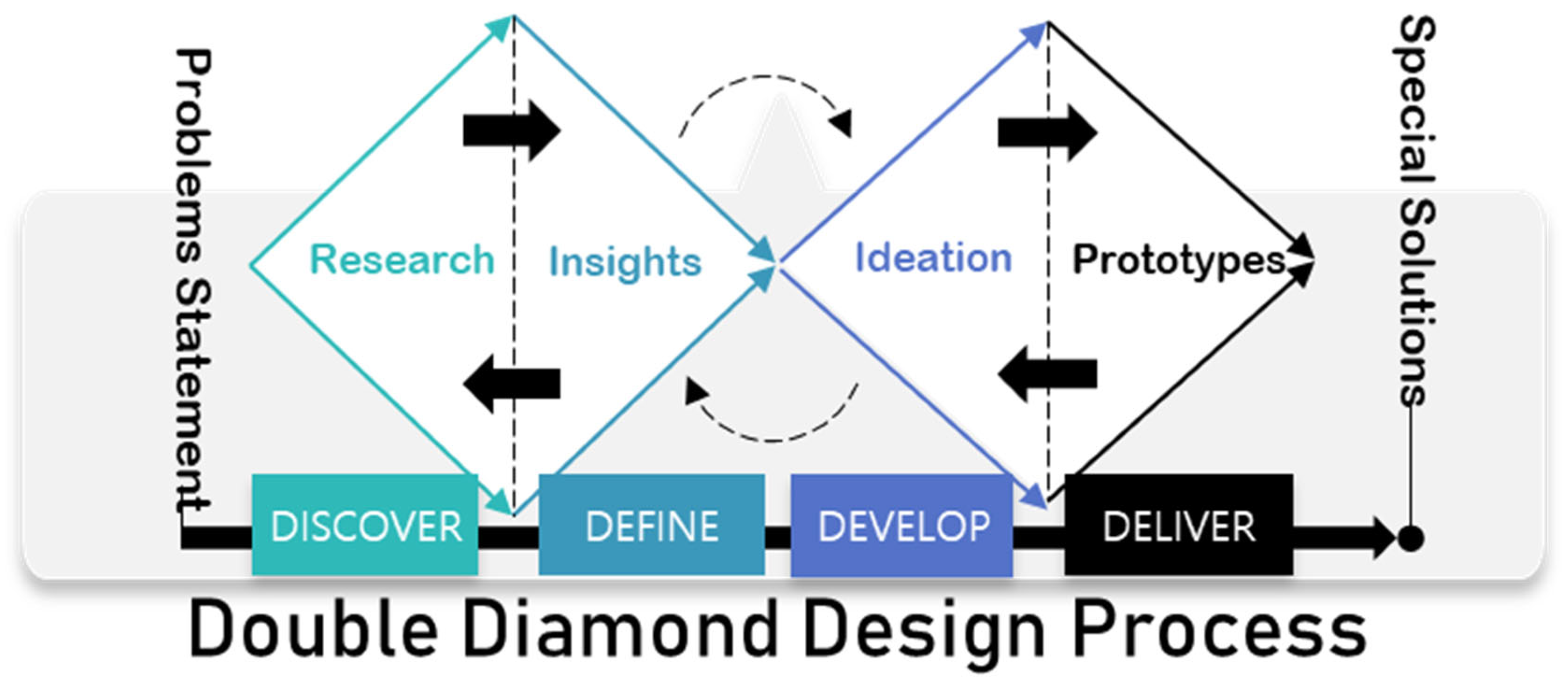
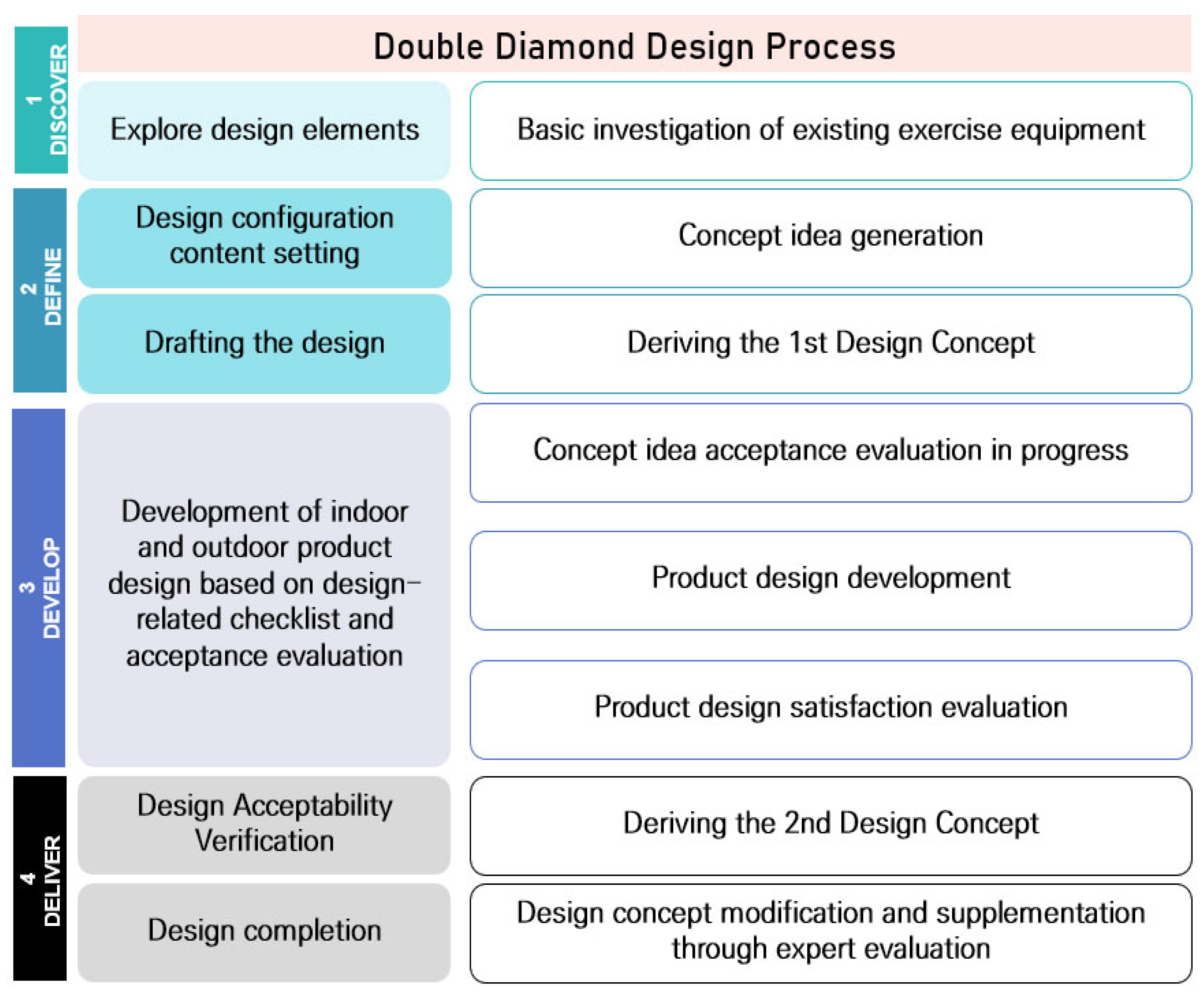
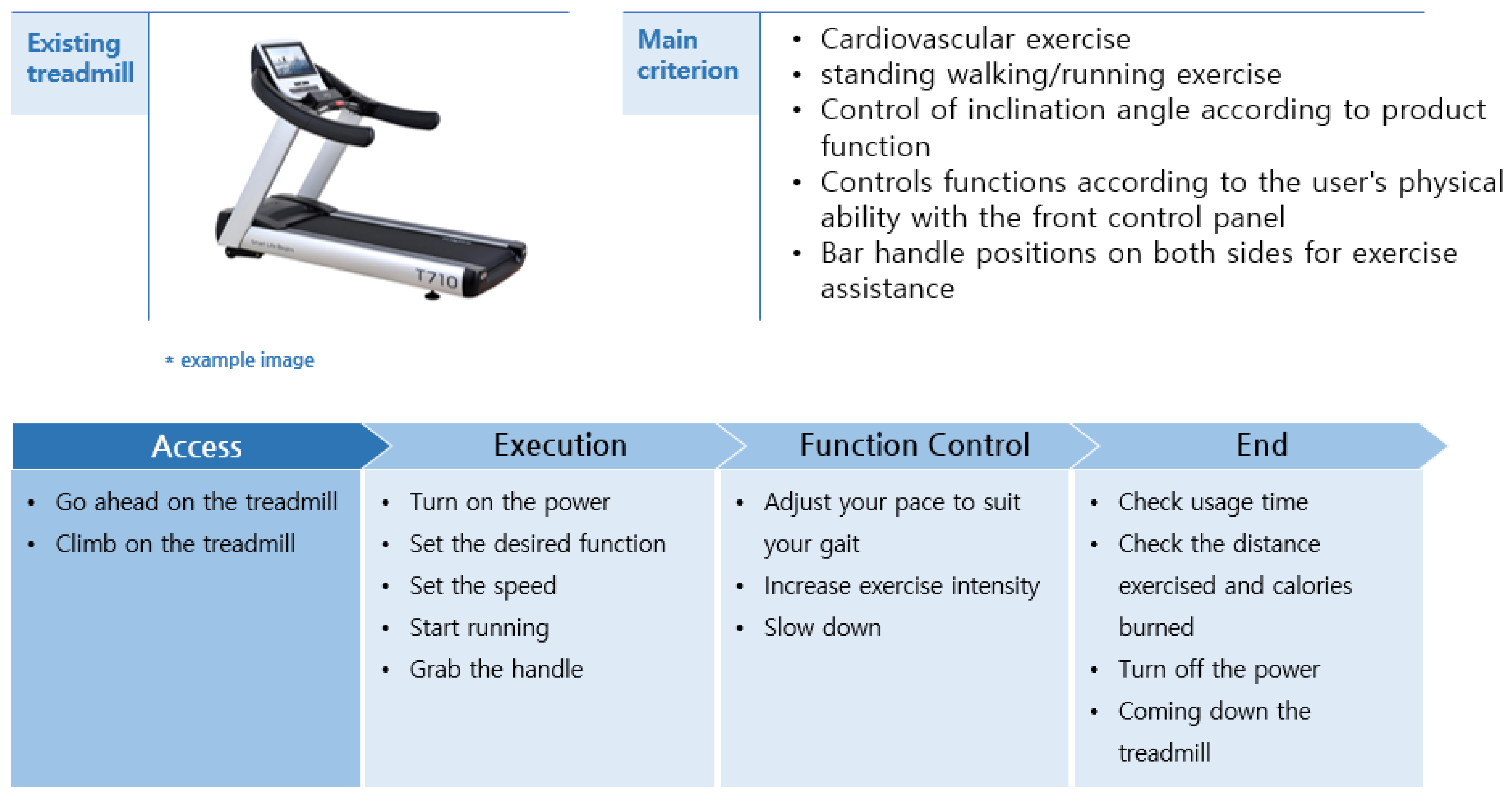
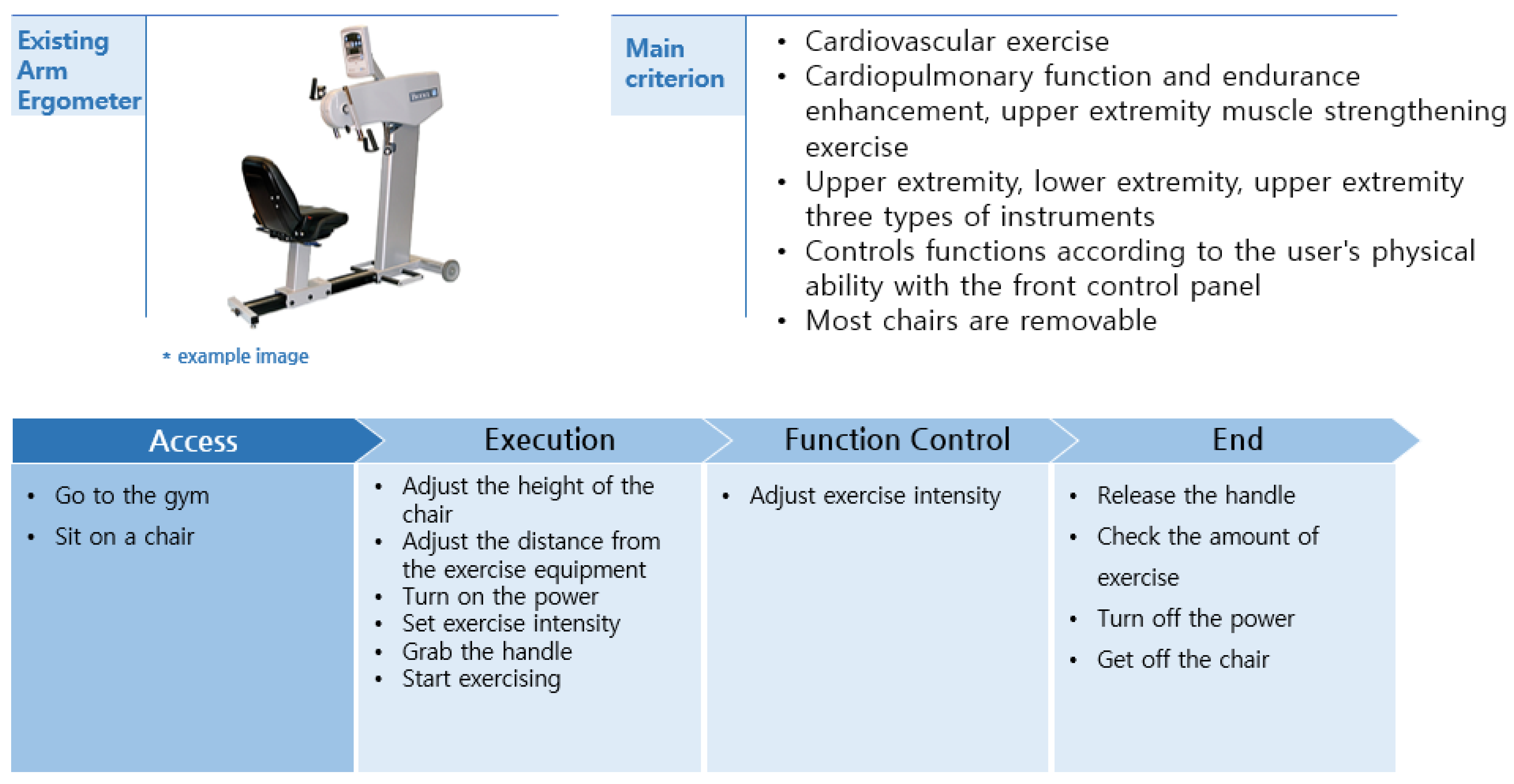
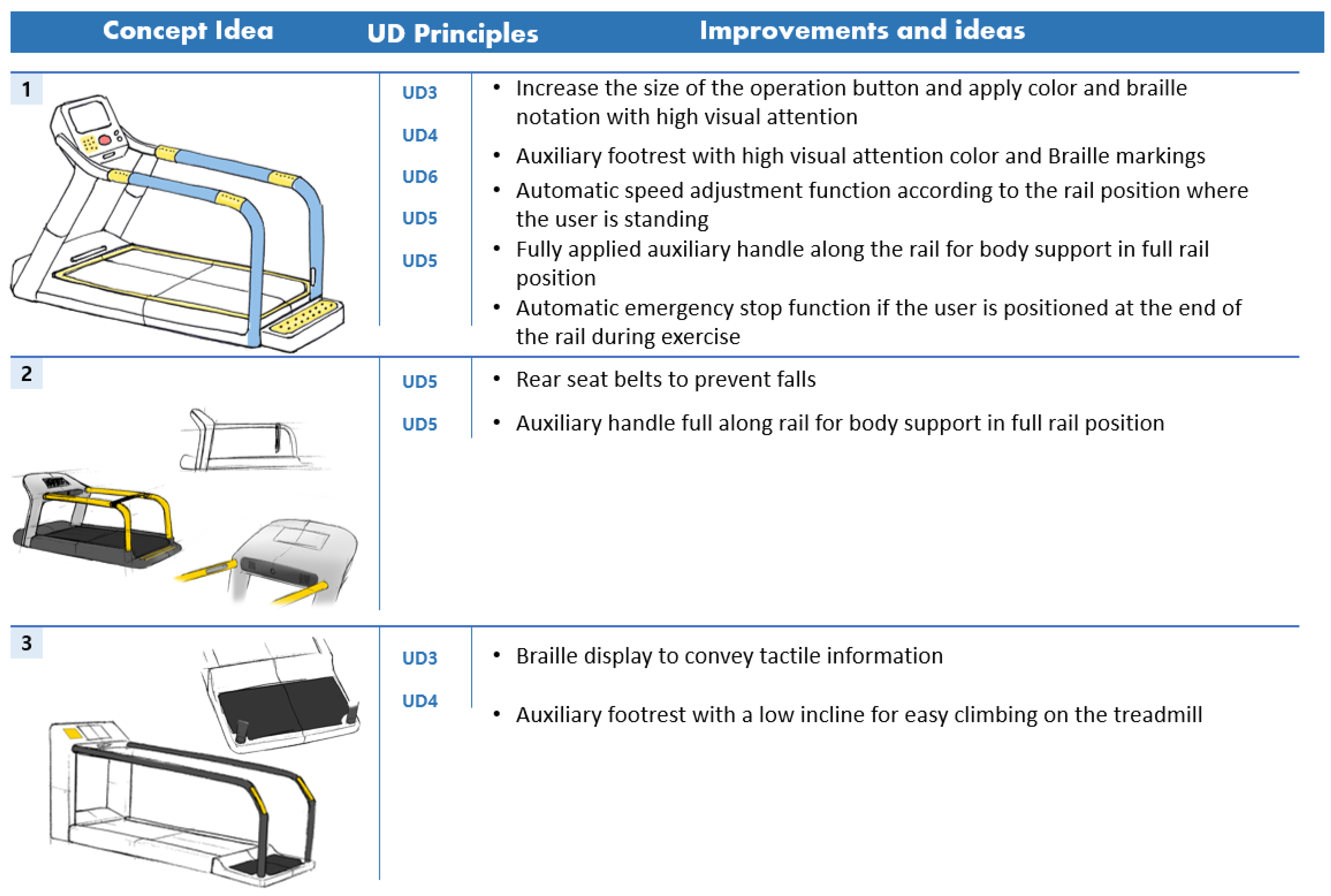
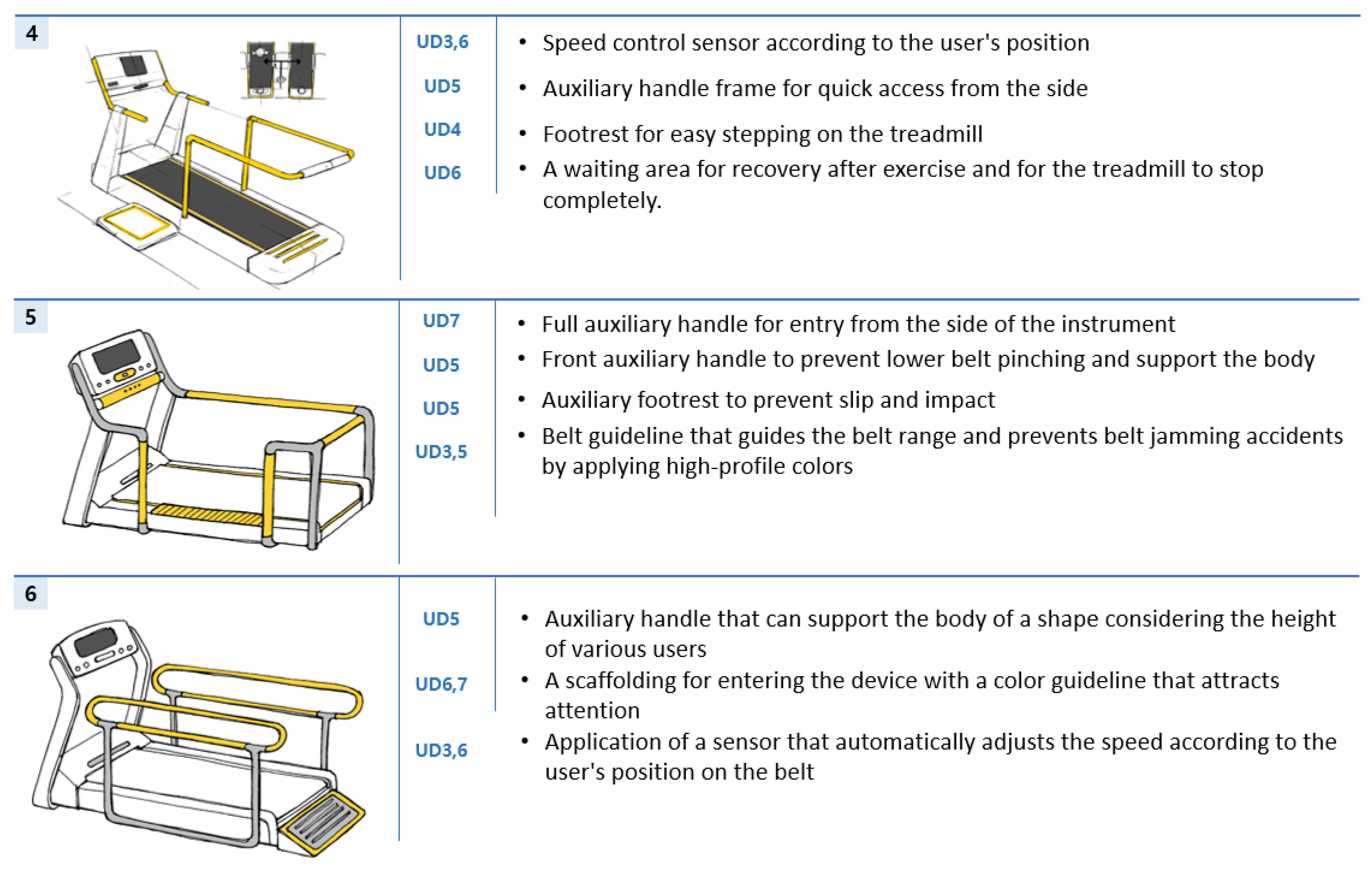
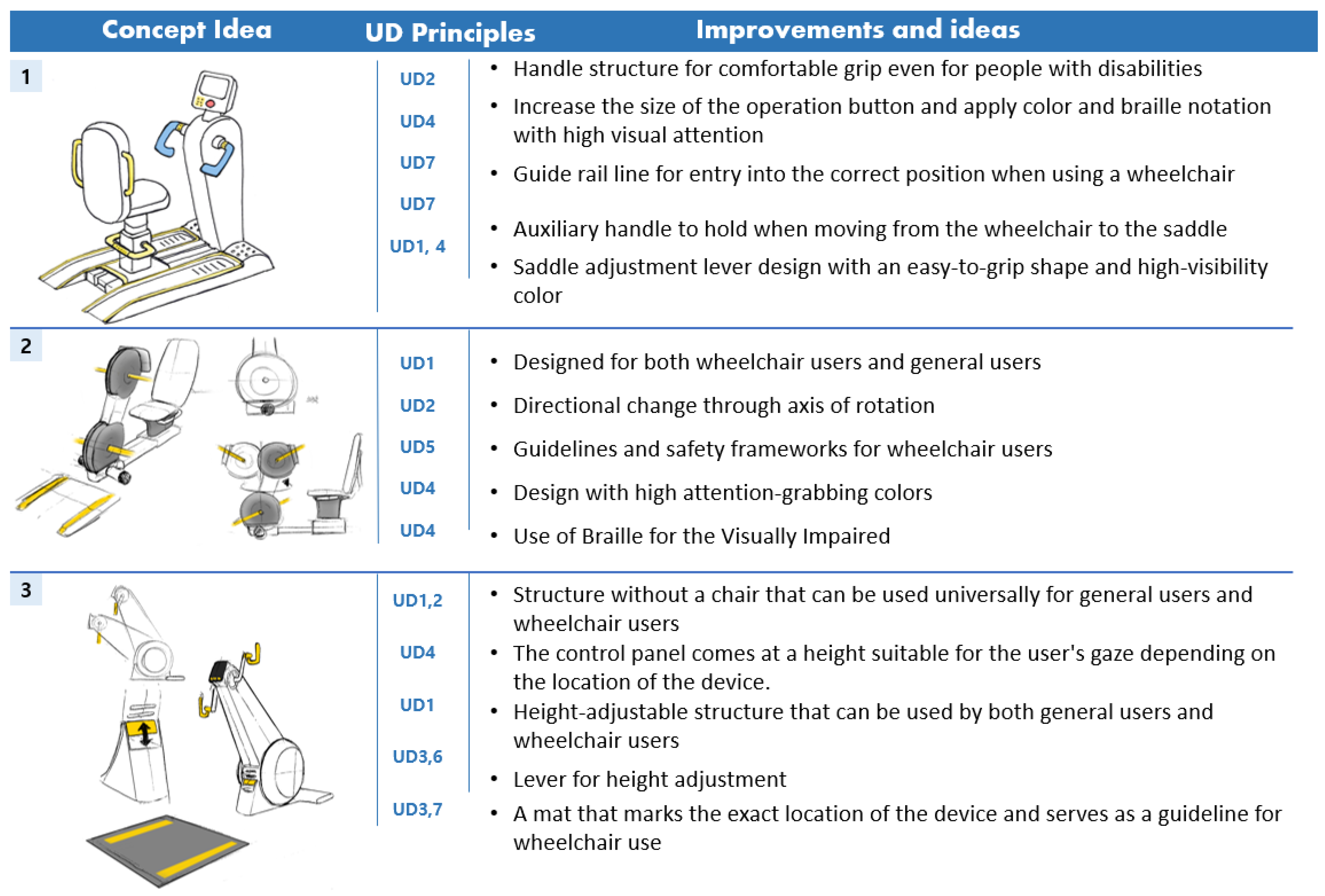
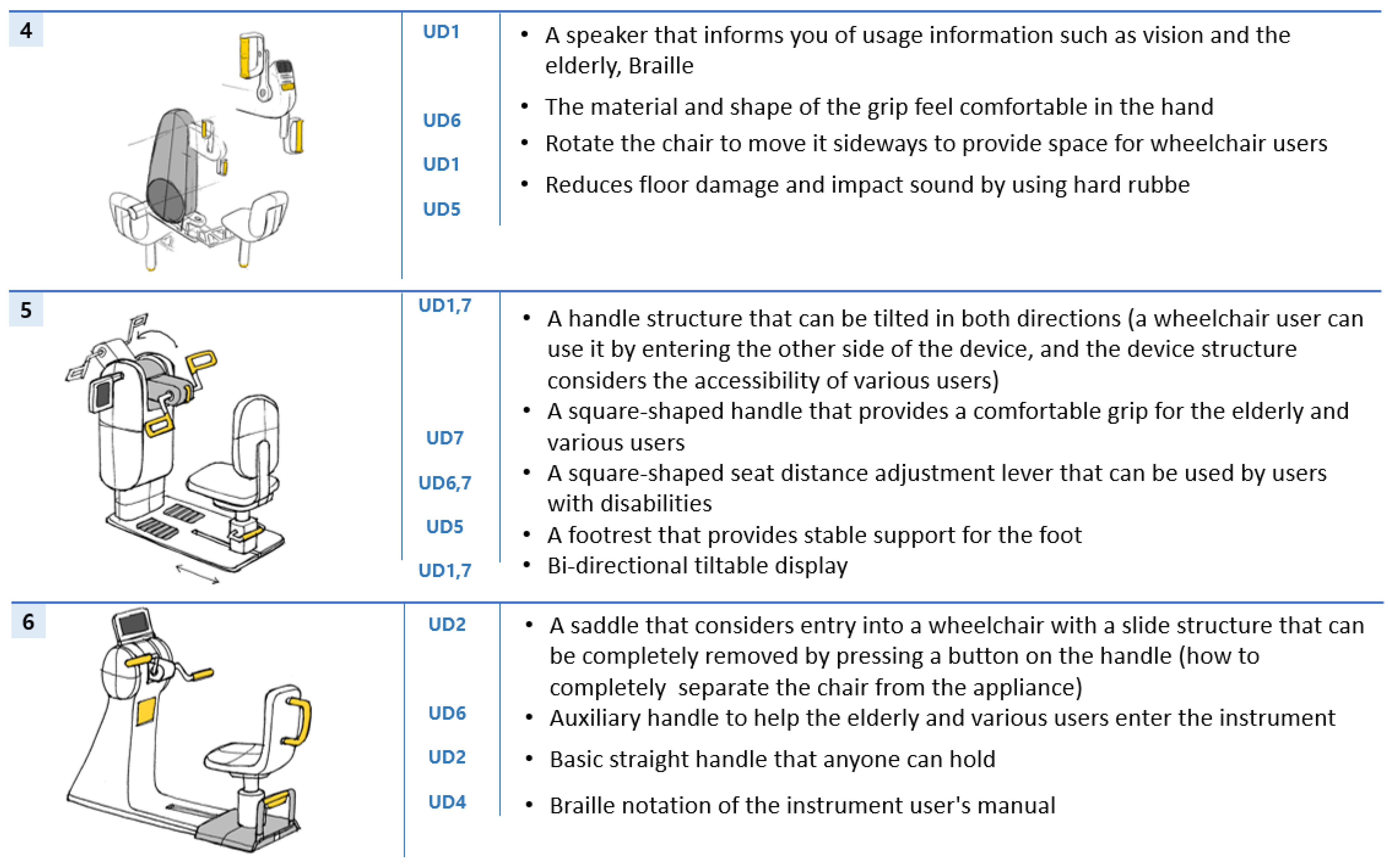
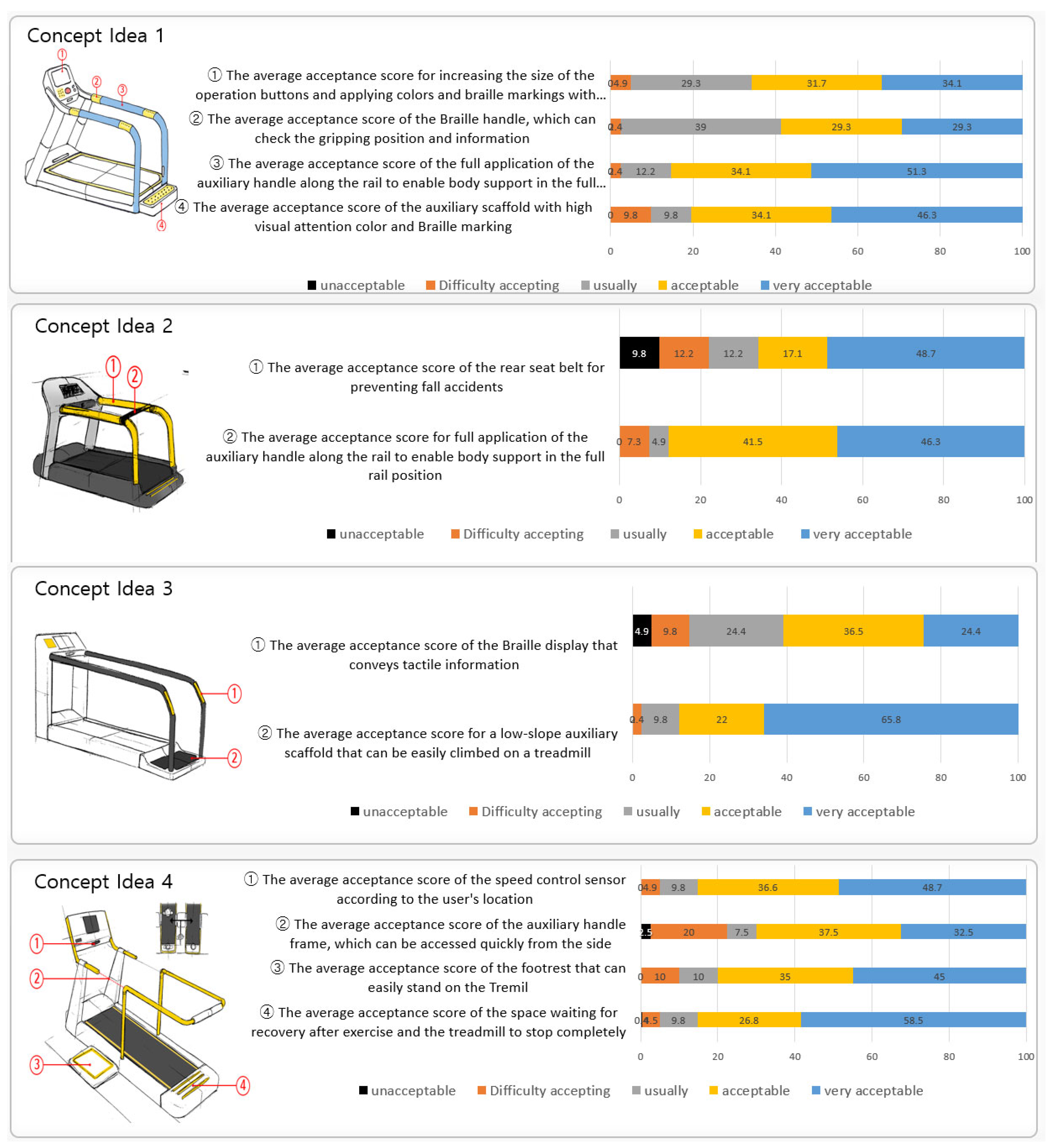
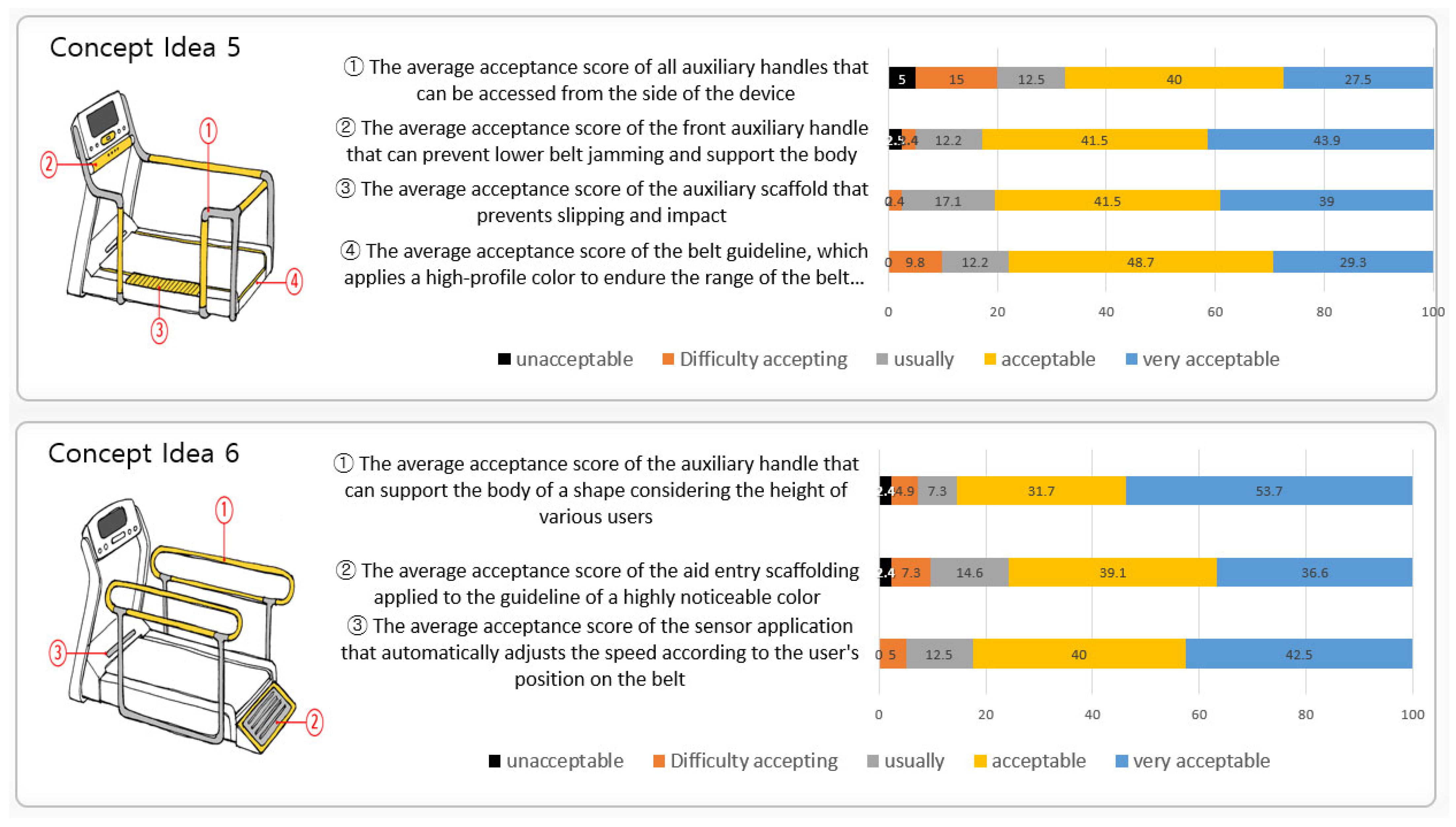
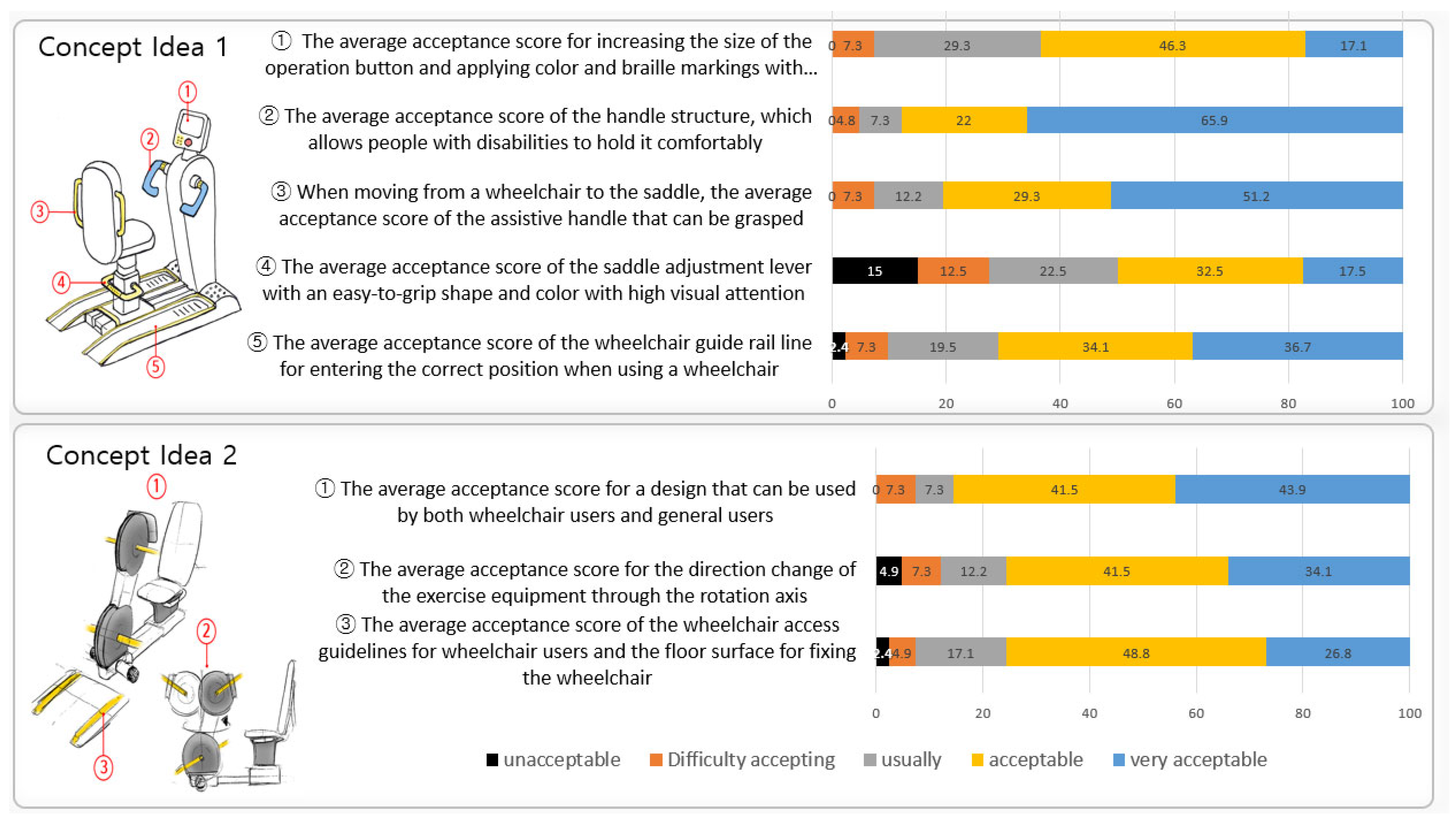
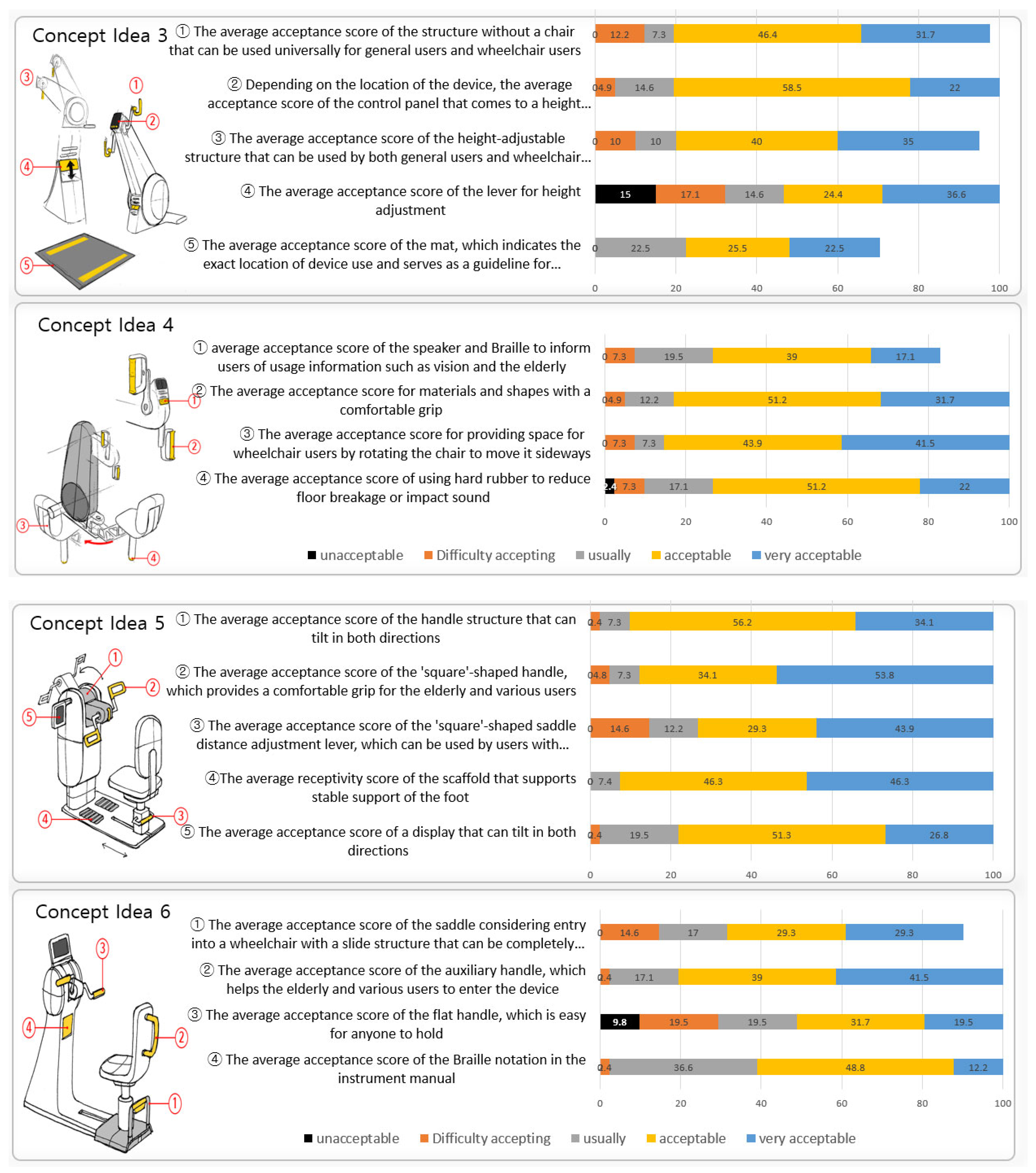
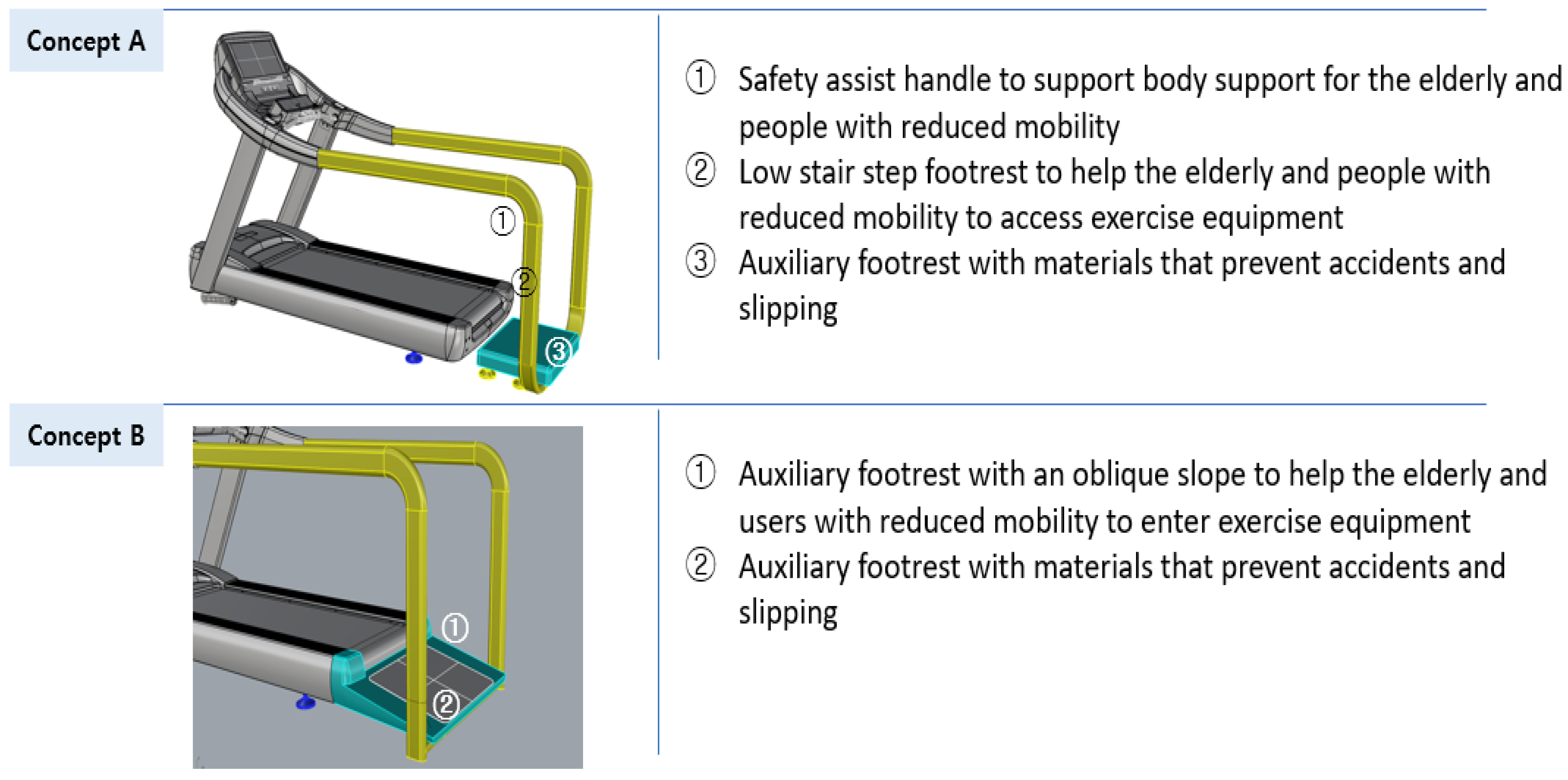
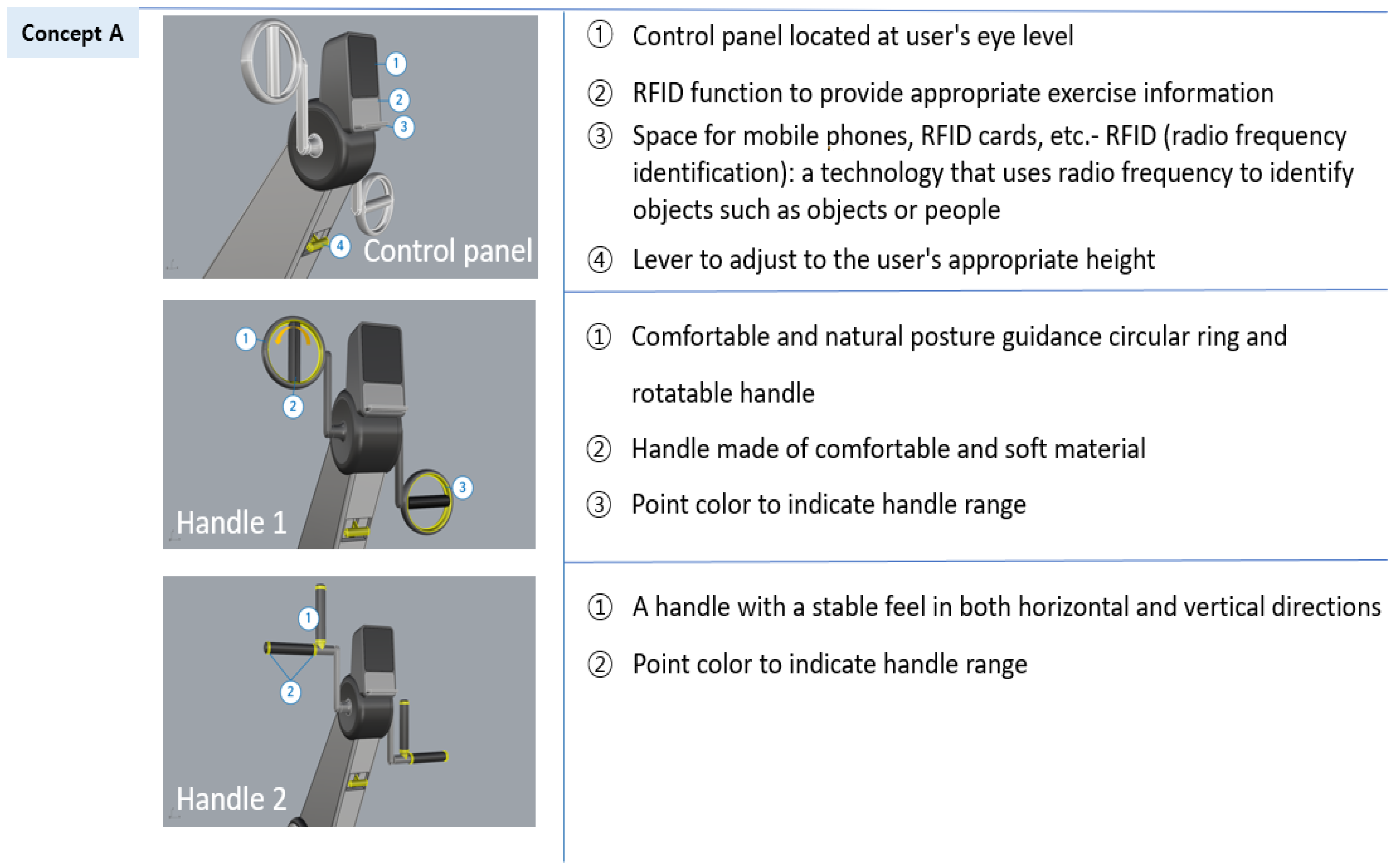
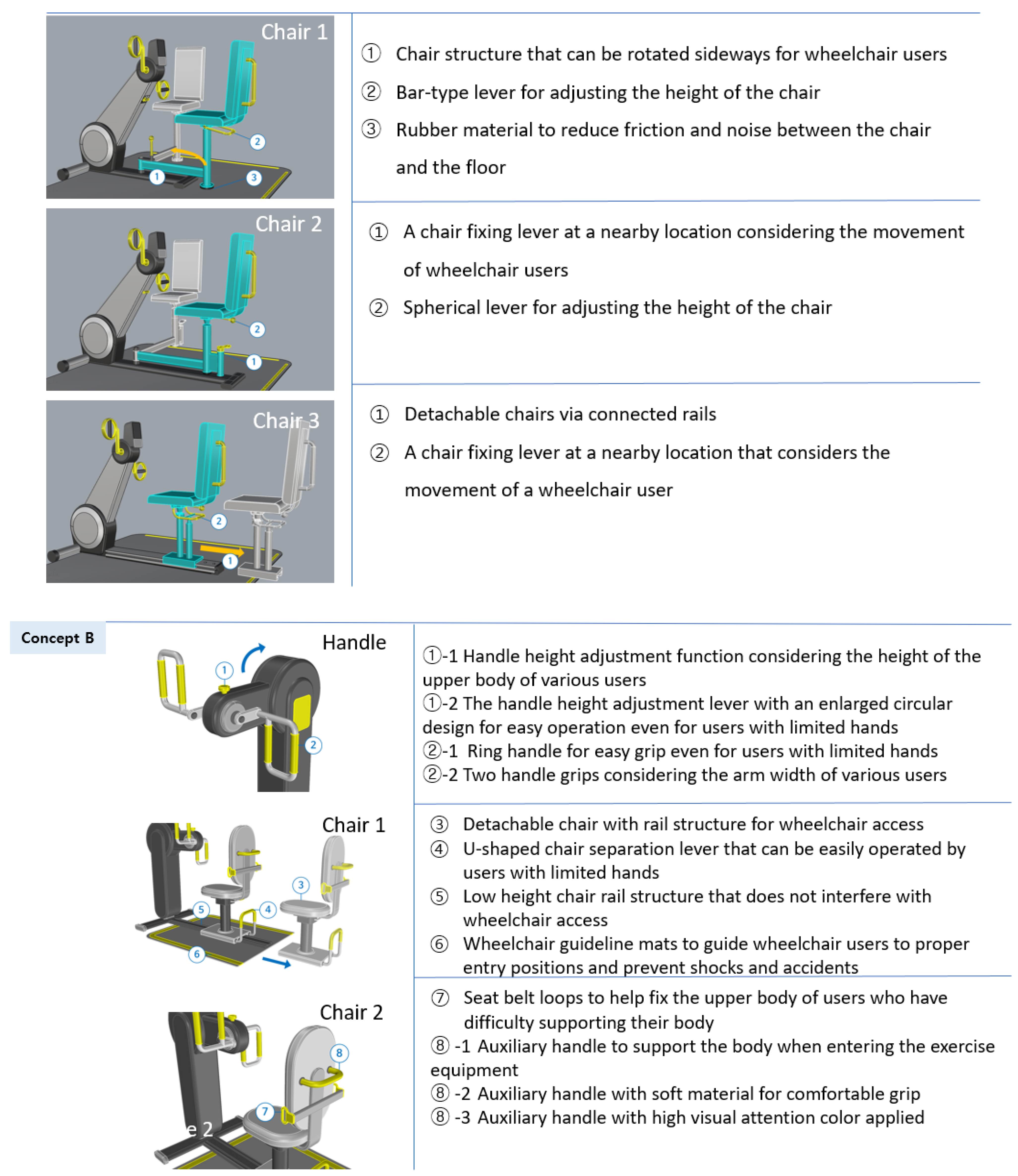
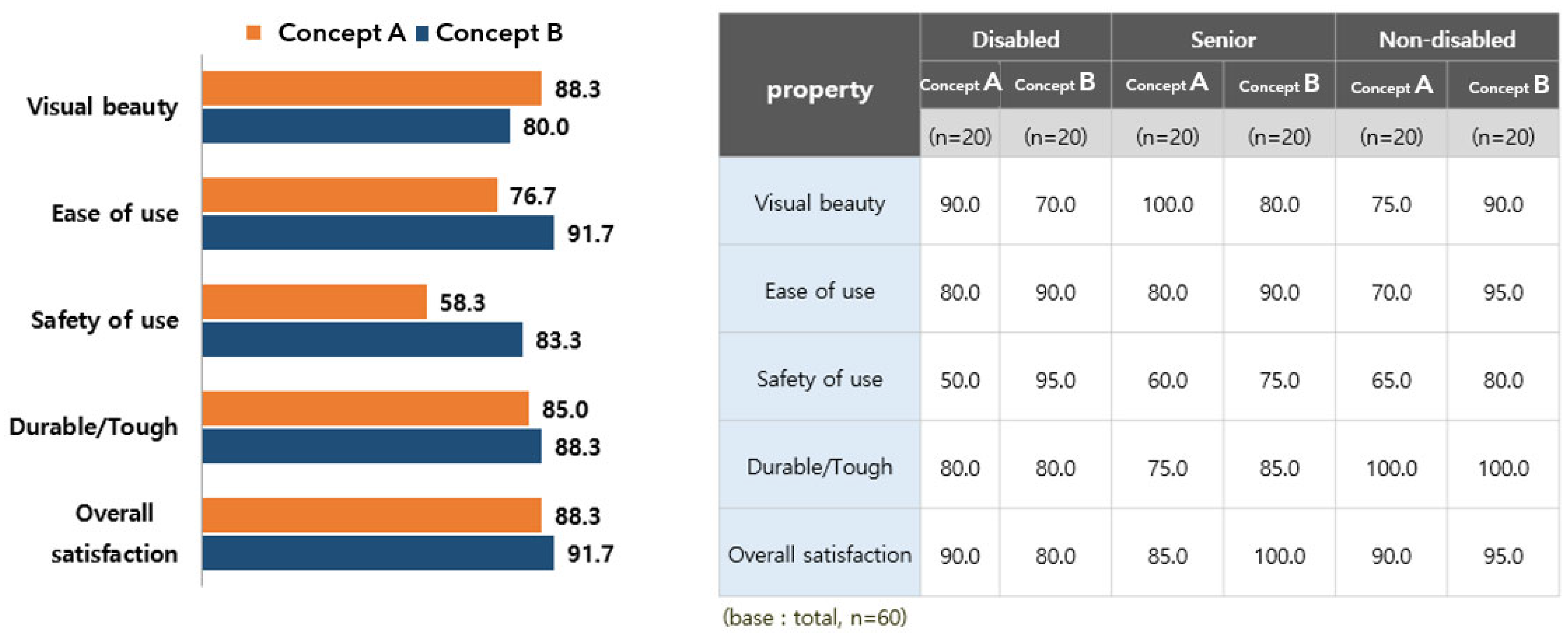
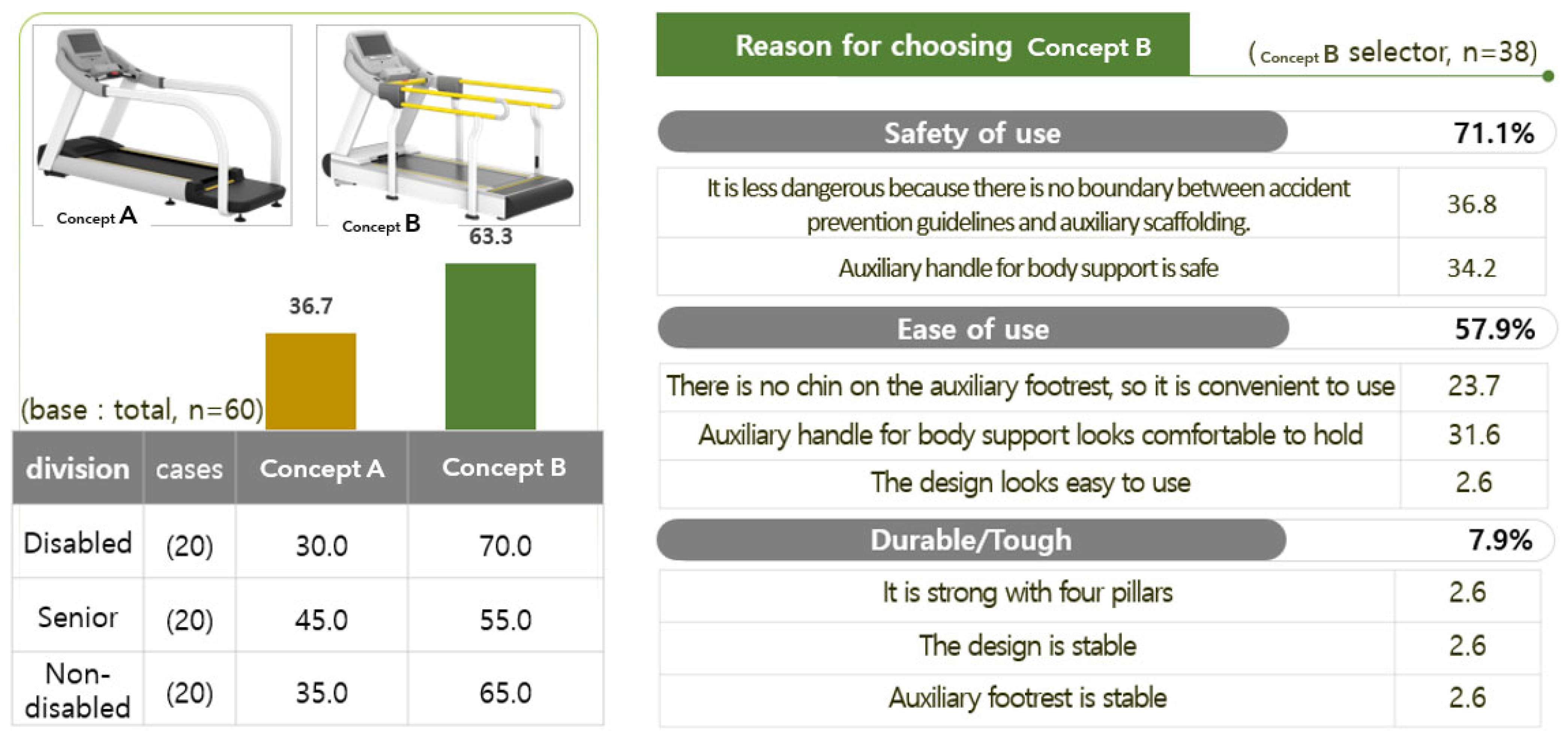
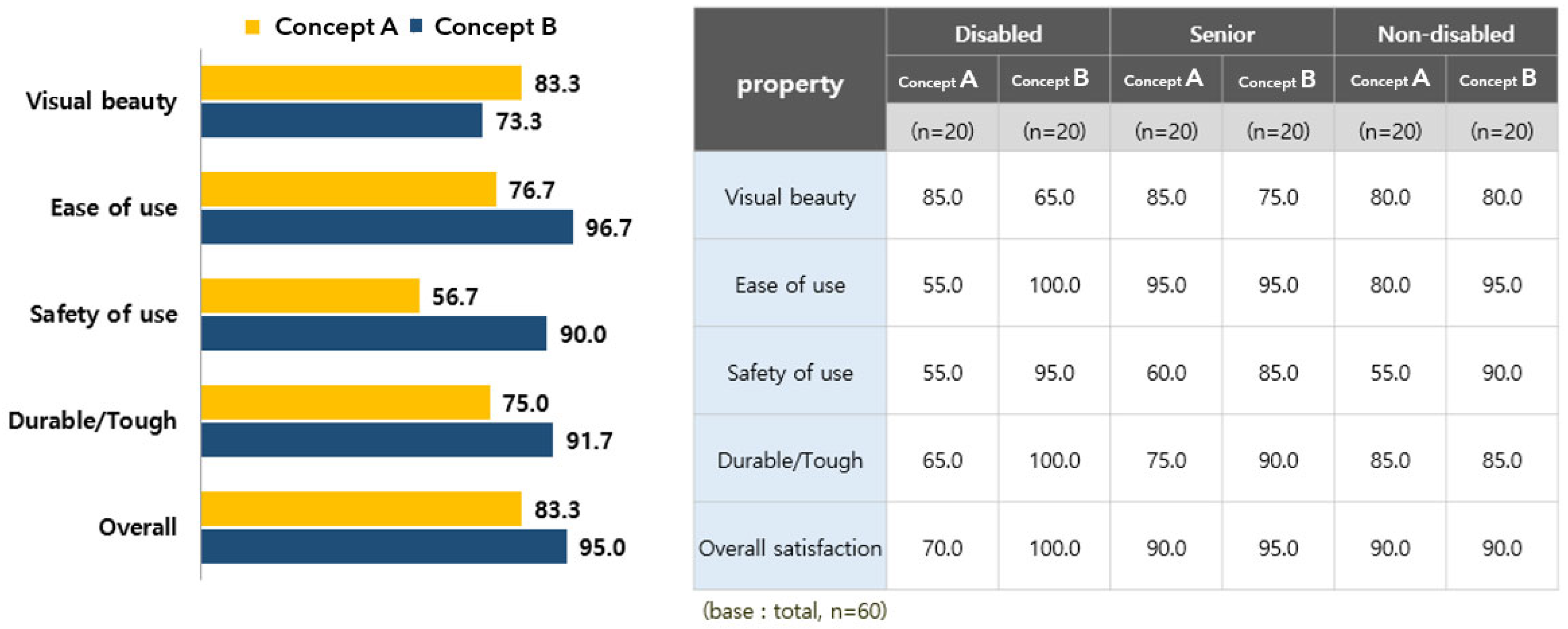
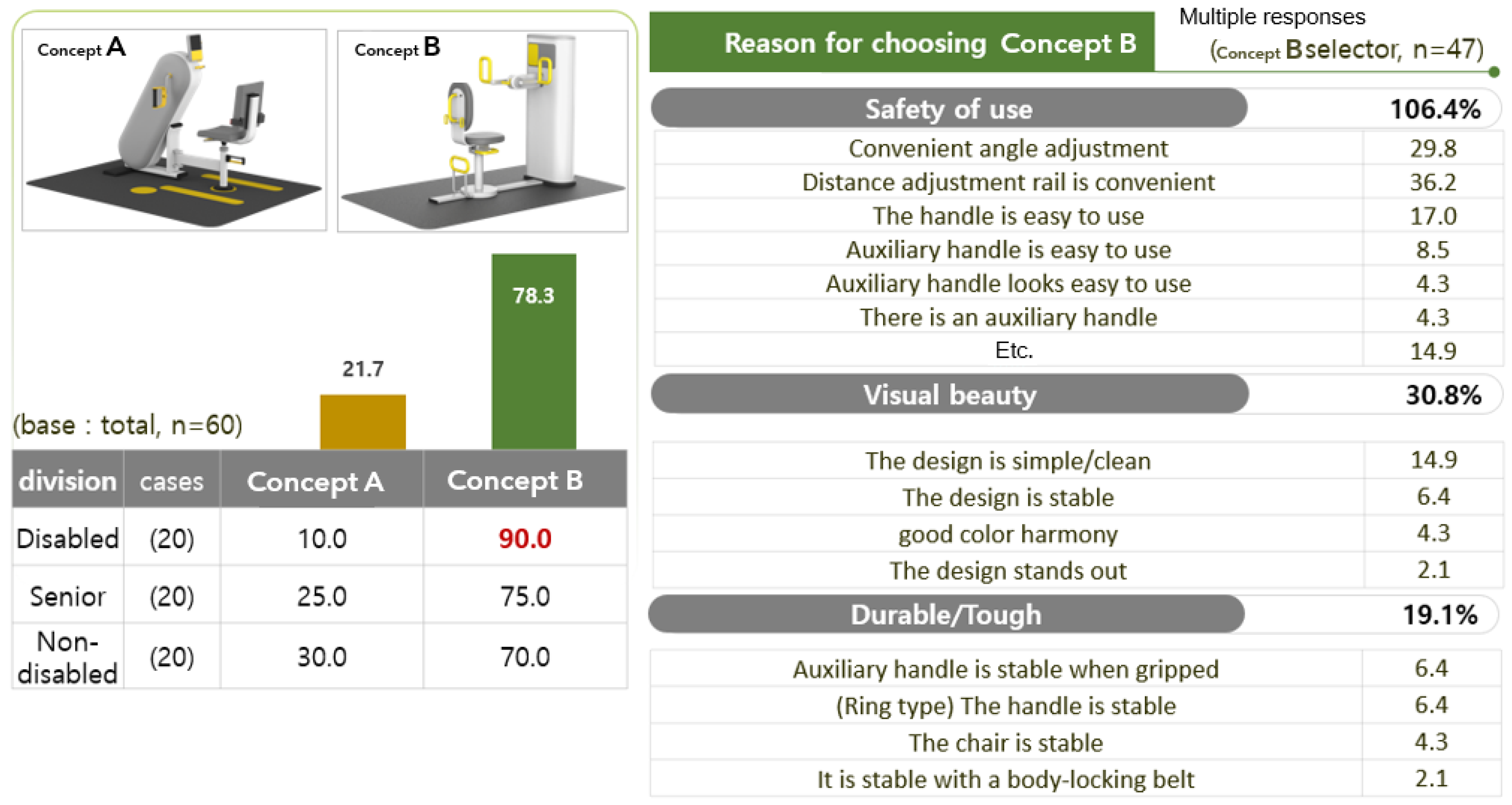
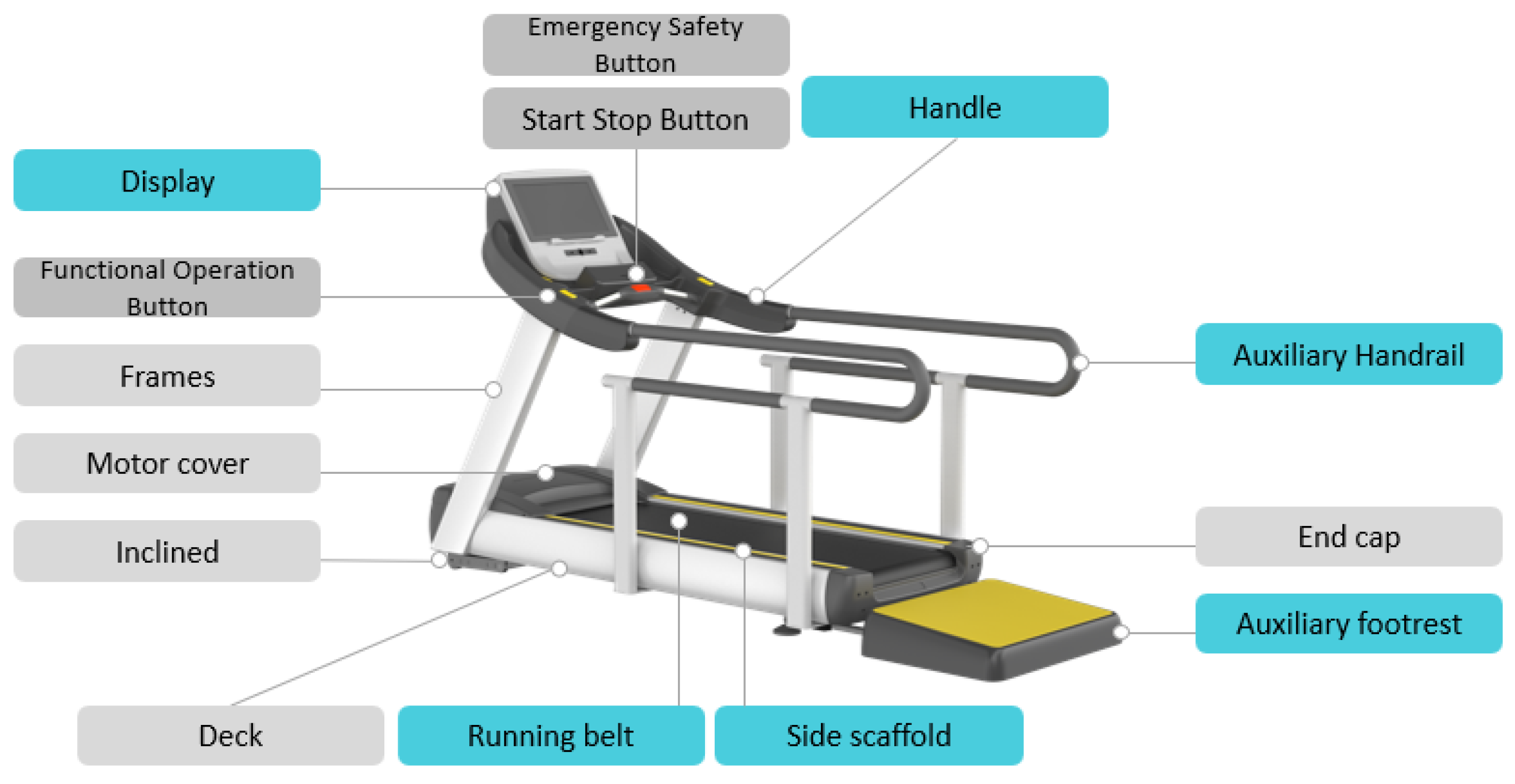
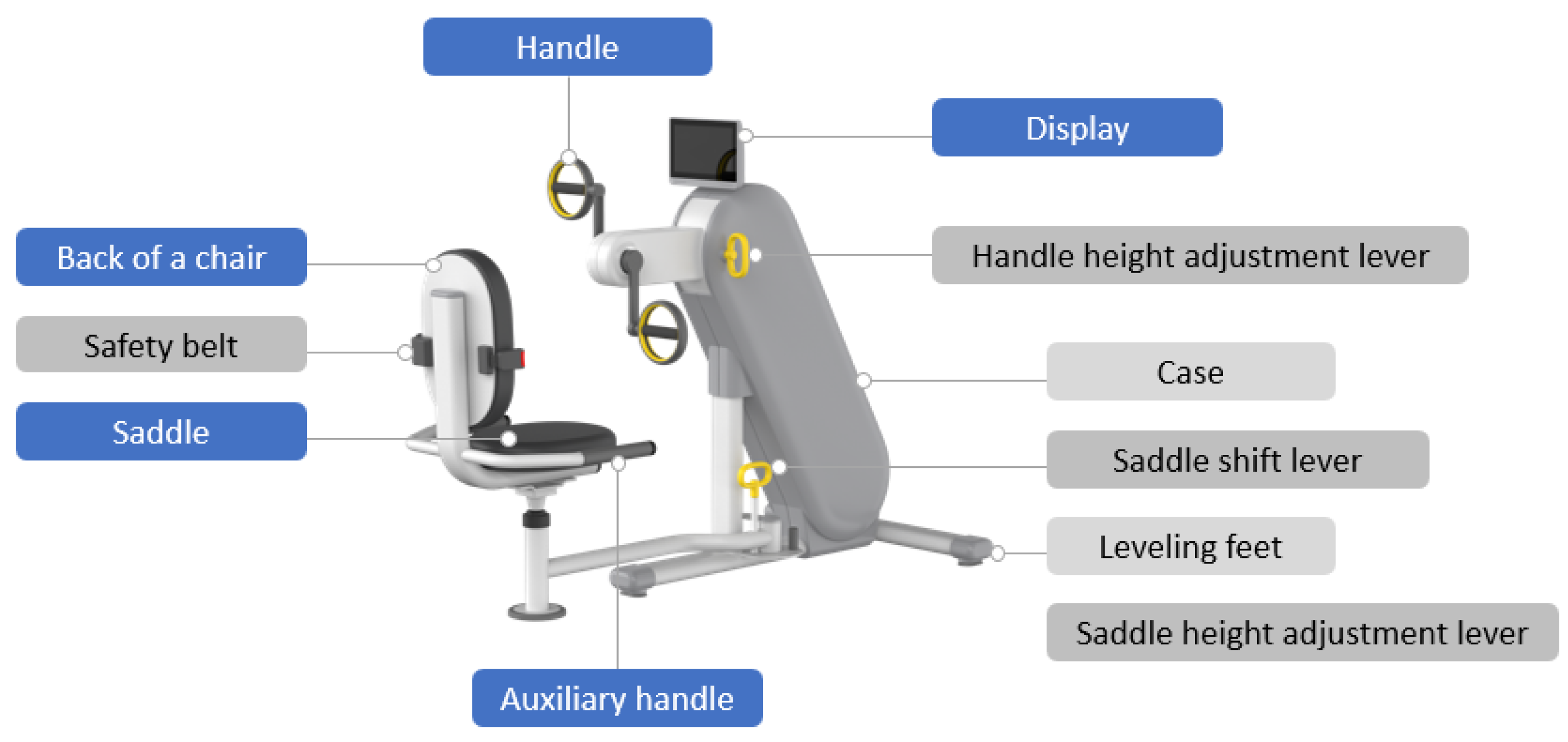
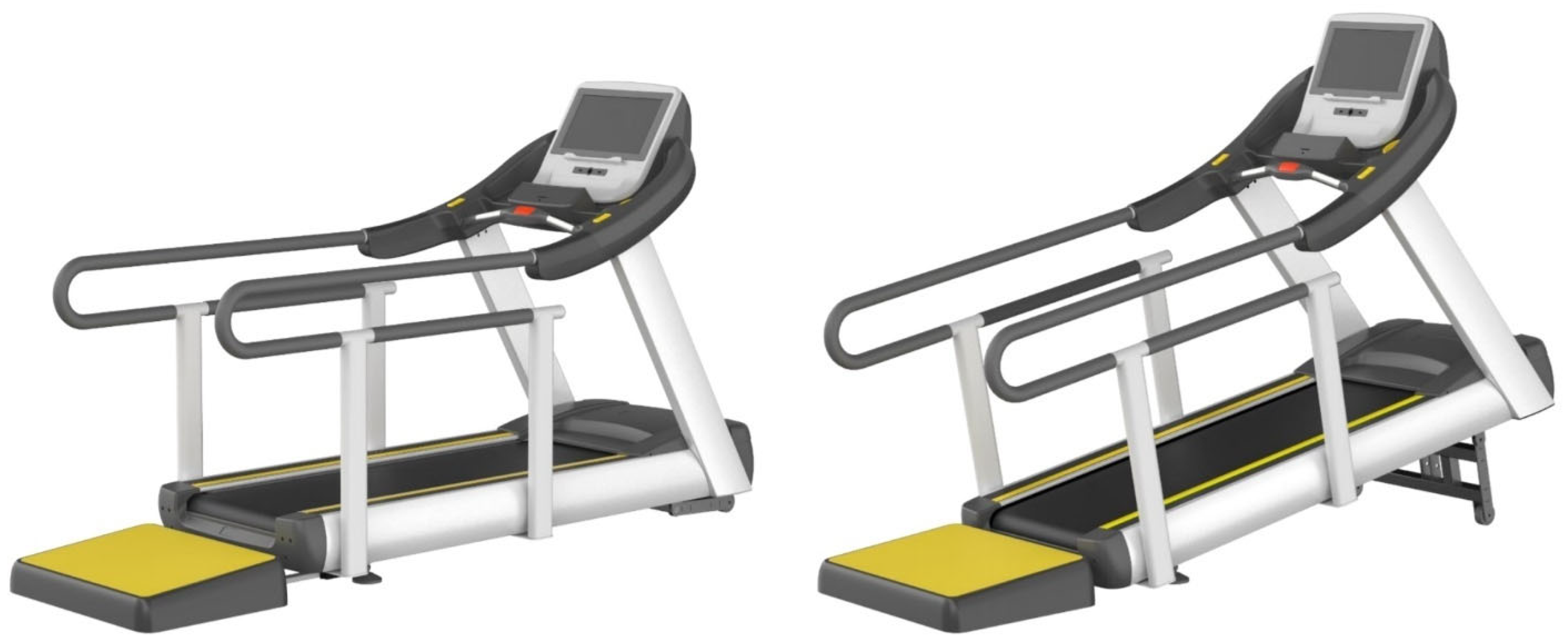
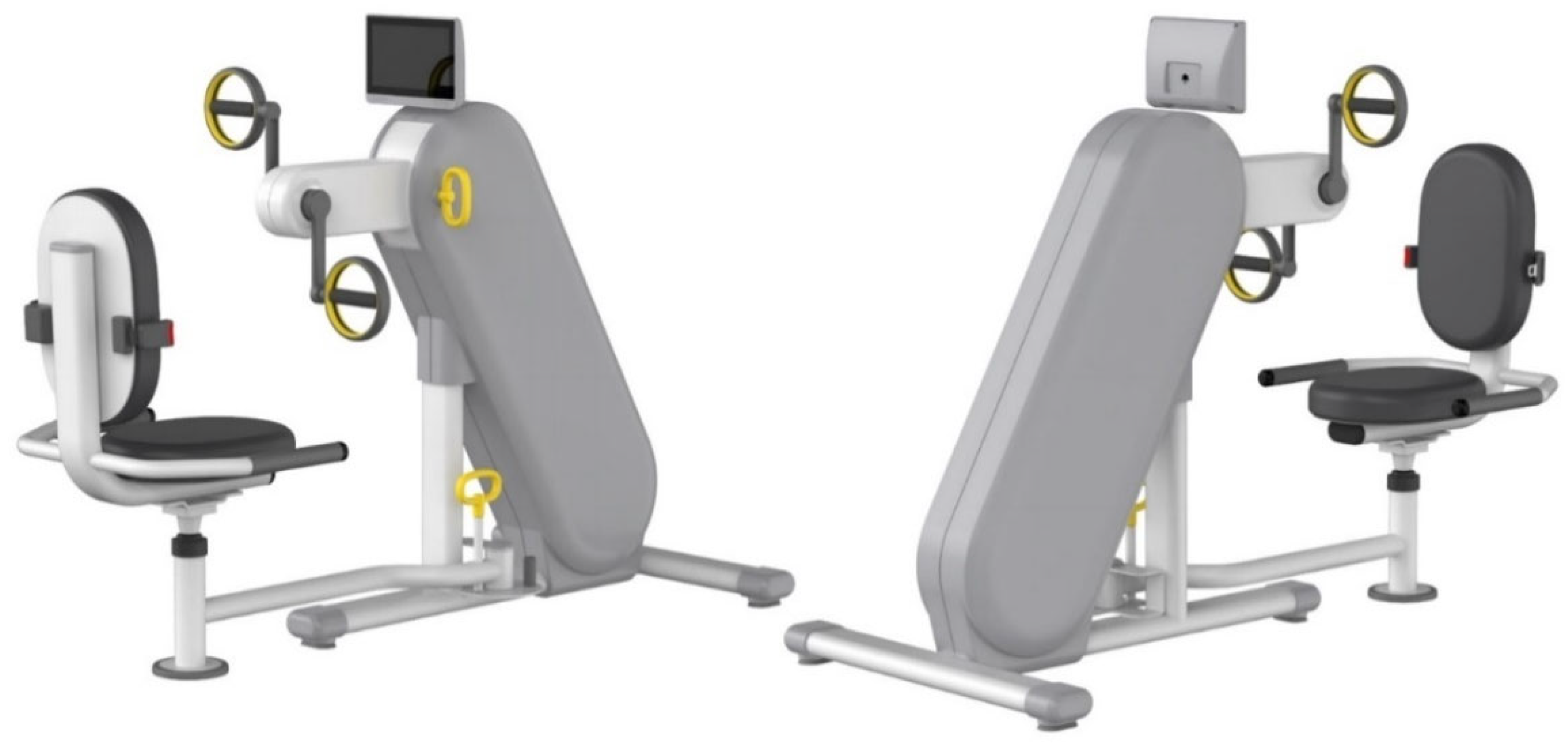
| Workplace | Region | Trainer Career (Year) |
|---|---|---|
| Seoul Underwater Rehabilitation Center | Seoul | 22 |
| Jeonglib hall | Seoul | 11 |
| Gwangju National Sports Center for the Disabled | Gwangju | 13 |
| Goyang Rehabilitation Sports Center | Gyeonggi | 32 |
| Seongnam Hanmaeum Welfare Center | Gyeonggi | 9 |
| Jecheon Eoullim Sports Center | Jecheon | 6 |
| Asan National Sports Center for the Disabled | Asan | 11 |
| Jeonju Ullim National Sports Center | Jeonju | 11 |
| Gwangyang National Sports Center for the Disabled | Gwangyang | 8 |
| Gumi City Disabled Gymnasium | Gumi | 33 |
| Changwon Municipal Gomduri National Sports Center | Changwon | 6 |
| Chuncheon Disabled Sports Center | ChunCheon | 7 |
| Seoul Gomduri Sports Center | Seoul | 25 |
| Workplace | Specialty | Position | Trainer Career (Year) |
|---|---|---|---|
| Hansung University | Design engineering | Professor | 24 |
| Saehan University | Design engineering | Professor | 22 |
| Hankyung University | Design engineering | Professor | 24 |
| Hongik University | Industrial design | Professor | 28 |
| Woosong University | Industrial design | Professor | 25 |
| Kookmin University | Industrial design | Professor | 14 |
| Seoul National University of Science and Technology | Design engineering | Professor | 21 |
| Seoul Design Foundation | Universal design | Senior Researcher | 24 |
| Korea University of Technology and Education | Design engineering | Professor | 26 |
| Korea Welfare University | Universal design | Professor | 18 |
| Division | People with Disabled (n = 133) | Senior (n = 131) | Non-Disabled (n = 132) | Total (n = 396) | |||||
|---|---|---|---|---|---|---|---|---|---|
| n | % | n | % | n | % | n | % | ||
| gender | male | 88 | 66.2 | 66 | 50.4 | 69 | 52.3 | 223 | 56.3 |
| female | 45 | 33.8 | 65 | 49.6 | 63 | 47.7 | 173 | 43.7 | |
| age | 20~29 | 12 | 9.1 | 0 | 0 | 18 | 13.6 | 30 | 7.6 |
| 30~39 | 18 | 13.5 | 0 | 0 | 20 | 15.2 | 38 | 9.6 | |
| 40~49 | 22 | 16.5 | 0 | 0 | 33 | 25 | 55 | 13.9 | |
| 50~59 | 49 | 36.8 | 0 | 0 | 61 | 46.2 | 110 | 27.8 | |
| 60+ | 32 | 24.1 | 131 | 100 | 0 | 0 | 163 | 41.1 | |
| type of disability | Brain lesion | 33 | 24.8 | - | |||||
| physical disability | 86 | 64.7 | |||||||
| Sensory impairment (visual, hearing) | 14 | 11.1 | |||||||
| degree of disability | mild | 76 | 57.1 | ||||||
| severe | 57 | 42.9 | |||||||
| Gender | Age | Participants | |||||||
|---|---|---|---|---|---|---|---|---|---|
| Male | Female | 20~29 | 30~39 | 40~49 | 50~59 | 60+ | People with | Non-Disabled | Senior |
| Disabled | |||||||||
| n (%) | n (%) | n (%) | n (%) | n (%) | n (%) | n (%) | n (%) | n (%) | n (%) |
| 27 (45.0%) | 33 (55.0%) | 3 (5%) | 7 (11.7%) | 5 (8.3%) | 15 (25.0%) | 27 (45%) | 10 (33.3%) | 10 (33.3%) | 10 (33.3%) |
| England | 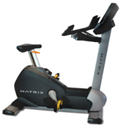 |  | 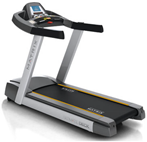 | |
| Company | Matrix | Matrix | Matrix | |
| Product | Recumbent Cycle | Upright Cycle | Treadmill | |
| Standard | 165.5 cm × 67 cm × 128 cm | 130 cm × 65 cm × 153 cm | 216 cm × 86 cm × 140 cm | |
| Target use | Blind and hearing-impaired users | Blind and hearing-impaired users | Blind and hearing-impaired users | |
| Certification | IFI Certification | IFI Certification | IFI Certification | |
| USA | 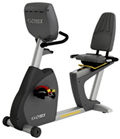 | 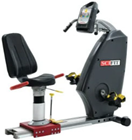 | 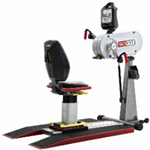 | |
| Company | CYBEX | Sci-Fit | Sci-Fit | |
| Product | Recumbent Cycle | Recumbent Cycle | Upper Body Ergometer | |
| Standard | 165 cm × 63.5 cm × 132 cm | 150 cm × 66 cm × 132 cm | 152 cm × 76 cm × 195 cm | |
| Target use | non-disabled, visually impaired, and elderly people users | Non-disabled, wheelchair users, disabled, elderly users (Removable Seat) | Non-disabled, wheelchair users, disabled, elderly users (Removable Seat) | |
| Certification | IFI Certification | IFI Certification | ADA Certification | |
| Republic of Korea | 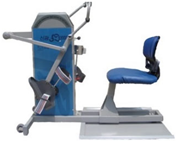 | 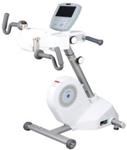 | 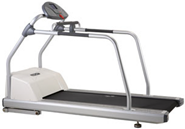 | |
| Company | Shinkwang Industrial Co., Ltd. | Sungdo MC Co., Ltd. | Sungdo MC Co., Ltd. | |
| Product | Recumbent Cycle/Upper Body Ergometer | Upper Body Ergometer | Treadmill | |
| Standard | 142 cm × 69 cm × 108 cm | 55 cm × 92 cm × 108 cm | 215 cm × 85 cm × 142 cm | |
| Target use | Non-disabled, wheelchair users, disabled, elderly users | Non-disabled, wheelchair users, disabled, elderly users | non-disabled, visually impaired, and elderly people users | |
| Certification | - | Korea Ministry of Food and Drug Safety Certification | Korea Ministry of Food and Drug Safety Certification |
| Status |
|
| Problem |
|
| Needs |
|
| Problems and needs | Access |
| |
| Execution Function Control |
| ||
| End |
| ||
| Concept Idea |
| ||
| Problems and needs | Access |
|
| Execution Function Control |
| |
| End |
| |
| Concept Idea |
| |
| Running belt |
|
| Auxiliary footrest |
|
| Handles and Auxiliary Handrails |
|
| Display |
|
| Operation button |
|
| Etc. |
|
| Saddle |
|
| Handle |
|
| Case |
|
| Display |
|
| Information board |
|
| Etc. |
|
Publisher’s Note: MDPI stays neutral with regard to jurisdictional claims in published maps and institutional affiliations. |
© 2022 by the authors. Licensee MDPI, Basel, Switzerland. This article is an open access article distributed under the terms and conditions of the Creative Commons Attribution (CC BY) license (https://creativecommons.org/licenses/by/4.0/).
Share and Cite
Yi, E.; Byun, H.; Oh, A. Development of Aerobic Exercise Equipment Using Universal Design: Treadmill and Arm Ergometer. Healthcare 2022, 10, 2278. https://doi.org/10.3390/healthcare10112278
Yi E, Byun H, Oh A. Development of Aerobic Exercise Equipment Using Universal Design: Treadmill and Arm Ergometer. Healthcare. 2022; 10(11):2278. https://doi.org/10.3390/healthcare10112278
Chicago/Turabian StyleYi, Eunsurk, Hyun Byun, and Ahra Oh. 2022. "Development of Aerobic Exercise Equipment Using Universal Design: Treadmill and Arm Ergometer" Healthcare 10, no. 11: 2278. https://doi.org/10.3390/healthcare10112278





